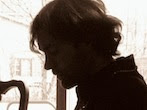My post today is about two albums, both bearing very similar titles: John Coltrane's Ascension and Glenn Branca's The Ascension. Both of these albums are avant-garde staples and both have their own legion of cultists.
Coltrane's Ascension serves as a watershed between his earlier more 'traditional' playing and his wild late style, which arguably found its greatest expression in 1966's Meditations and the wonderful duet with drummer Rashied Ali, Interstellar Space. The most striking thing about Ascension is its sheer wall of sound. It was recorded with a 'big band' featuring his usual group of McCoy Tyner on piano, Jimmy Garrison on upright bass, Elvin Jones on drums, as well as Marion Brown and John Tchicai on alto sax, Art Davis on a 2nd upright bass, Freddie Hubbard and Dewey Johnson on trumpets, and Pharoah Sanders and Archie Shepp joining Coltrane on tenor sax.
That rhythm section has been described as 'monolithic' and that's about right.
The album opens and closes with a variation on the opening theme of Coltrane's masterpiece A Love Supreme, then proceeds from there into outer space and back; a soundscape that pulls itself apart and reforms endlessly, like some 13th century Lurianic Kabalist's reconfiguration of the ten Sefirot...
It can be overwhelming on first listen, but a deeper look reveals layer upon layer of skronk giving way to bluesy modal solos, hints of New Orleans funeral marches, circular rhythms interlocking and then unraveling and then coming back together.
I have frightened people out of the room with this record, and others have literally hugged the stereo. At right around 40 minutes its some of the most concentrated and intense playing ever laid down.
Glenn Branca's record The Ascension has some of the same visceral quality - sheets of sound, throbbing rhythms - but moves in a darker atmosphere altogether. Scored for four guitars, bass and drums, the record features Lee Ranaldo (later of Sonic Youth fame) on one guitar, Branca on another, Ned Sublette (later a World Music composer) and David Rosenbloom on the other two, Jeffrey Glenn on bass and Stephan Wischerth on drums.
The Ascension sounds like NYC in the late 70's and early 80's must have looked and felt like (captured most spectacularly in Luc Sante's essay "My Lost City") - a neo-dystopian fusion of rotting splendor and absolute freedom.
The bass is a menacing rumble. The guitars are spiky, angular, lean, precise, savage, cacophonous. This music seems lit by some half-forbidden subterranean light leaking out of abandoned subways at 4am. It seems architectural and chaotic at once. Full of danger and ecstasy. A catalog of the city's ghosts. A requiem for every junkie, prostitute, bum and criminal that's ever looked up into the gray sky above the crazy wastes and searched for some shred of sentience...
Sonic Youth has been mining this same territory ever since with their own brand of controlled chaos (and as far as I'm concerned hitting their stride with the pastoral gorgeousness of 1985's Bad Moon Rising), but nothing has come close to the absolute beauty and terror of this masterpiece.
Tuesday, March 26, 2013
Subscribe to:
Post Comments (Atom)

No comments:
Post a Comment